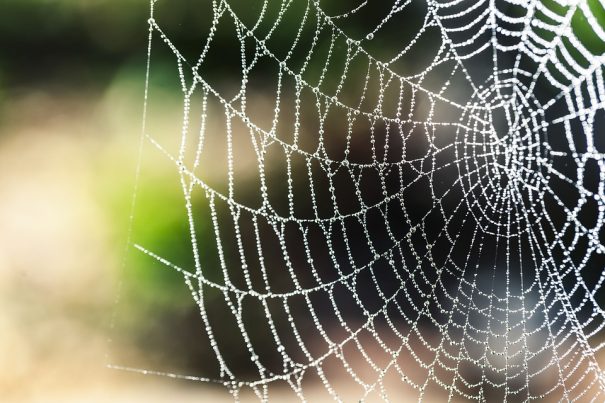
Spider silk is so strong that researchers can use it to improve the performance of piezoelectric nanogenerators
Wednesday, August 15, 2018 by Edsel Cook
http://www.futuresciencenews.com/2018-08-15-spider-silk-is-so-strong-piezoelectric-nanogenerators.html

Spider silk is pretty strong stuff. It’s so strong, Indian and South Korean researchers are using it to create nano-scale piezoelectric generators. In an article in Nanowerk, the researchers reported getting spider silk molecules to generate an electric charge when placed under physical pressure.
This was the first time a piezoelectric response has been elicited from spider silk. Professor Bhanu Bhusan Khatua of the Indian Institute of Technology Kharagpur (IIT Kharagpur) explained that they discovered natural silk fibers responded to pressure from vertical, out-of-plane directions.
“Although spider silk fibers show nature’s most outstanding mechanical properties, for example, excellent tensile strength and elasticity, and remarkable protein sequence structure, it remains completely unidentified how the mechanical properties of spider silk fibers effectively contribute to the performance of a piezoelectric nanogenerator (PNG),” Khatua explained in an interview.
He and the Pohang University of Science and Technology (POSTECH) study group led by Jin Kon Kim achieved the effect by applying tensile strength in the parallel direction to the fiber. They believed that the unorthodox piezoelectric effect depended on the unique structure of the spider silk.
Their approach directly used unmodified silk fibers. The success of their experiment showed that the fibers do not need to be specially treated to be used as a piezoelectric material. (Related: Nano-sized cellulose fibers beat spider silk in being the strongest material on Earth.)
Spider silk generates piezoelectricity in an odd way
Study author Sumanta Kumar Karan of IIT Kharagpur said that earlier studies on the piezoelectric property of spider silk did not consider applying external force from vertical/out-of-plane to the direction of the fiber. Their experiment showed that silk fibers have strong vertical piezoelectricity.
Karan theorized that the property stems from the complicated structure of spider silk. Each fiber is made up of highly-organized micro-fibrils, betas-sheet crystal, alpha-helix, a carbonyl group, and inter/intra-molecular hydrogen-bonding.
“The interaction between the crystalline domains and the strained elastic semi-amorphous regions could be the origin behind the extraordinary properties of silk fibers fiber,” agreed POSTECH researcher Sandip Maiti, the co-first author of the paper alongside Karan.
In their experiment, Maiti, Karan, and the other researchers used spider silk fiber to build a piezoelectric nanogenerator so that they could study its ability to harvest energy from pressure. They reported that the bio-generator achieved significant output voltage with matching instantaneous power density.
They added that the generator performed effortlessly when it came to accumulating biomechanical energy.
“Our device also shows excellent energy conversion efficiency of ?66%, which are highest values among all the reported bio-based PNGs till date, to the best of our knowledge,” Katua remarked. “A single flexible silk fiber PNG can turn on 30 green LEDs through simple finger imparting. An assembly of three devices in series shows a maximum output voltage of ?65 V, which instantaneously can turn on more than 55 combined LEDs.”
He went on to say that the spider silk-based piezoelectric nanogenerator demonstrated the highest (66 percent) energy conversion efficiency among all of its biologically-based counterparts.
Spider silk fibers could power smart clothing
A single silk fiber PNG could turn finger pressure into electricity for 30 green light-emitting diodes (LEDs). A series assembly of three such devices could instantly turn on at least 55 combined LEDs.
The PNG device of the IIT Kharagpur-POSTECH researchers is a one-dimensional nanowire. The wire can keep a significant output voltage while it is being bent, imparted, and stretched.
One of the potential uses for this PNG is providing electrical power for smart clothing. Not only is the spider silk fiber device bio-compatible, but it is also capable of picking up arterial pulses, throat movements, and other normal signals given off by physiological activity. It could, therefore, be employed as a biomedical sensor.
Read about other biotechnological advances at FutureScienceNews.com.
Sources include:





